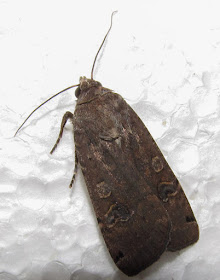The mystery.
I gave it grass, since that's what it was eating when I first found it, and thankfully the caterpillar was satisfied with its simple diet. Soon, it progressed through its instars, darkening from a light green to a yellow-green and brown color.
After a few weeks, the caterpillar pupated and mostly just sat around while its insides were reorganizing and making it more furry. And at last, it eclosed into a moth!
At last, I had enough data for an ID. It was a bittersweet moment: the moth is a non-native introduction from Europe. One thing did make up for it though:
At least it's pretty!
This is the Large Yellow Underwing, which goes by the regal name of Noctua pronuba. The orange hindwings, hidden by the drab brown forewings, lend the species its common name. Underwings are moths that will surprise you, and the bursts of color seen during their flight are reminders that moths still have some tricks up their sleeves.
I must also say that I'm very glad to have authentic insect pins. They make the pinning process so much simpler and are long enough that I can get good use out of my Styrofoam pinning board. For another illustration of my pinning technique, here's another moth I pinned, from this past weekend.
This is the Grapevine Epimenis, Psychomorpha epimenis. I came across this moth while walking with a group along a dirt road on a chilly but sunny Saturday. It landed near us and I snapped it up. Kaufman's Field Guide to Insects of North America helped me quickly narrow down the species by providing a clear picture and noting its tendency to fly on "warm days in early spring." It wasn't super warm, but the sunshine helped! The caterpillars of this species feed on grape leaves, hence the name. It's a small moth, with a wingspan of a little over 1 inch, but its size doesn't take away from its bold patterning and coloration. The more I look at it the more I think I may need to move it to the top of my list of favorite moths.










